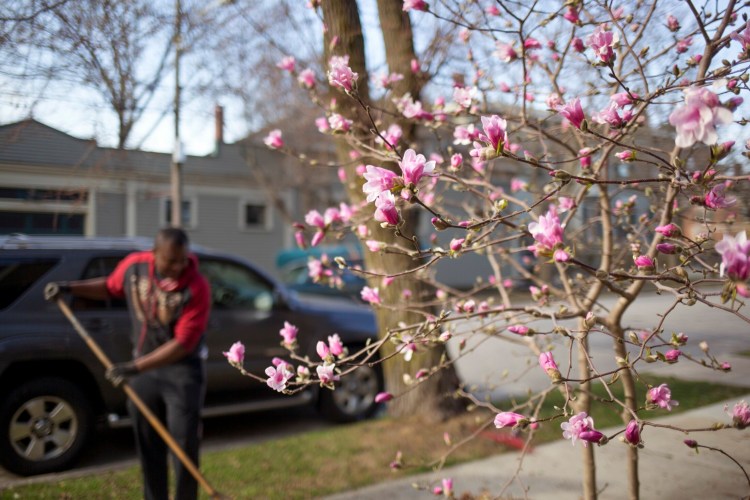I am a firm believer that it is impossible to have too much information, despite the cliche that says you can. What you can have is too many opinions, especially in this internet age. People just love to tell us what we’re doing wrong.
A friend sent me an email wondering when she should clean up her gardens. She’s been gardening for years, and thought she was doing things the way they should be done. But now, she is being told she is doing it all wrong, inadvertently killing many beneficial insects such as native bees and butterflies.
This column is intended to put her mind, and other gardeners’ minds, to rest.
At the turn of the 21st century, garden cleanup was straightforward. If you liked the look of the plants standing up above the snow here in Maine, you left them until spring. If you didn’t, you cut them down in the fall. Almost everyone cut down the foliage that flopped over after being frozen, like day lilies. Life, or at least garden cleanup, was simple.
You raked most of your leaves in the fall, but you had to rake again in the spring because over the winter leaves blew in from wooded areas – whether on your property or not – where no one raked. Most of those leaves collected around shrubs and the perennials you hadn’t cut back.
One Facebook post I saw insisted that we shouldn’t do spring cleanup until the temperature has been 50 degrees for at least seven straight days. I ignored it because if most Mainers waited that long, spring cleanup would interfere with Memorial Day preparations, as well as transplanting peppers, tomatoes and other seedlings into the vegetable garden and tender annuals both into the ground and in pots. We can’t have that.
Yes, delaying the cleanup has its benefits. The hollow stems of standing perennials provide homes for the eggs and developing stages of beneficial insects, such as bees and butterflies. A layer of leaves will also provide shelter for small but helpful creatures. So do keep some areas undisturbed, but you needn’t leave your entire yard that way. Remember, it’s your garden. You want to share it with the native wildlife, but it is yours to enjoy. If you find the brown stems and leaf piles ugly, remove them.
There are many things you can do now. First, the many windy days this spring may have knocked down branches. Pick them up and pile them up.

Atwell discovered this wild black cherry tree growing on his property last August. He was thrilled, as the tree generously feeds many kinds of wildlife. Photo by Tom Atwell
In our garden, in a section that’s about a quarter of our yard we do nothing except cut down the Norway maples that sprout from seeds that float in from neighboring yards. That area has native red oaks, red maples, a pine and, I discovered last year, black cherry trees. If you want to feed the insects, leave the fallen branches in a woodland area of your yard. And it goes without saying that if your yard has an unusually high number of dead tree branches, you need to check out your trees. Something might be injuring them.
Your woodland area is also the place you can leave the stems of perennials you removed from the garden beds. The beneficial insects can live in them there as well as in the highly visible parts of your ornamental gardens. The leaves, too, can go there. We keep our compost bins in that area, filling them with the leaves, and I am sure that many of the beneficial insects that live in these fallen leaves can survive being hauled to a different section of the yard.
It’s all about compromise, and people are showing more concern for wildlife, as proven by the email that prompted this column. For starters, many fewer people are using insecticides and herbicides on their gardens. Some communities have banned them, while many people — including my wife and I — just don’t want to use them.
Yes, you should grow native plants, but you don’t have to limit yourself to those. The New York Times had an article in late March promoting serviceberry (the botanical name is Amelanchier), instead of traditional spring bloomers like daffodils. I say grow both, maybe even with the daffodils underneath the serviceberry. The Times writer mentioned Doug Tallamy recommending that people turn half their lawn into beneficial native plants. Great. Follow Tallamy, and plant the other half with attractive non-natives if you want them.
Likewise, when cleaning up, balance your own convenience and desires with benefits to the environment.
Tom Atwell is a freelance writer gardening in Cape Elizabeth. He can be contacted at: tomatwell@me.com
Send questions/comments to the editors.



Success. Please wait for the page to reload. If the page does not reload within 5 seconds, please refresh the page.
Enter your email and password to access comments.
Hi, to comment on stories you must . This profile is in addition to your subscription and website login.
Already have a commenting profile? .
Invalid username/password.
Please check your email to confirm and complete your registration.
Only subscribers are eligible to post comments. Please subscribe or login first for digital access. Here’s why.
Use the form below to reset your password. When you've submitted your account email, we will send an email with a reset code.